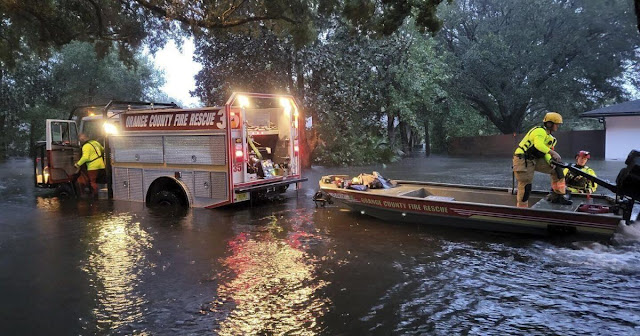 |
| Credit: Olean Times Herald |
After one of the most powerful storms to ever hit the U.S. mainland caused tens of billions of dollars in damage and more than 20 fatalities, Hurricane Ian, which devastated Florida, North, and South Carolina, required a massive clean-up on Saturday.
Images from the National Oceanic and Atmospheric Administration revealed that Ian's storm surge completely destroyed several beach cottages and a motel building that lined the shores of Florida's Sanibel Island. The images revealed that although most homes were still standing, they appeared to have roof damage.
According to the National Hurricane Center, Ian, a post-tropical cyclone, was weakening but was still expected to bring dangerous weather to some areas of the Carolinas, Virginia, and West Virginia into Saturday morning.
"Through the following week, central Florida will continue to experience major to record river flooding. This weekend, there is a slight chance of flash, urban, and small stream flooding across the central Appalachians and the southern Mid-Atlantic, and there is a slight chance of river flooding over the coastal Carolinas "It read.
On Wednesday, the storm hit Florida's Gulf Coast, turning beach towns into disaster zones. It battered waterfront Georgetown, South Carolina's historic city, on Friday with winds that reached 85 mph (140 kph).
Several piers were damaged, and roads were flooded and blocked by trees.
According to the tracking website PowerOutage.us, at 8:00 a.m. ET (1200 GMT) on Saturday, about 1.7 million homes and businesses in the Carolinas and Florida were without electricity.
The number of fatalities and repair costs are still unknown, but as Florida entered the third day after Ian's initial strike, the extent of the damage was becoming clear.
Kevin Guthrie, director of the state's Division of Emergency Management, stated on Friday morning that there have been reports of at least 21 deaths, stressing that some of those are still pending confirmation.
He estimated that 10,000 people were missing, but many of them were probably in shelters or without electricity. Governor Ron DeSantis said, "Those older homes that are just not as strong built, they got washed into the sea."
It would be very challenging to survive if you were to bunker down in that, in my opinion. According to U.S. property data and analytics company CoreLogic, insurers were preparing for a hit of between $28 billion and $47 billion from what could be the costliest Florida storm since Hurricane Andrew in 1992.
Following the approval of a disaster declaration by US President Joe Biden, federal assistance is now available to storm-affected counties.
"The scope of that destruction is only now starting to become clear. It's likely to be one of the worst in the country's history, "said he. On Saturday, Biden issued a similar proclamation in North Carolina.
 |
| Credit: REUTERS |
 |
| Credit: REUTERS |
 |
| Credit: REUTERS |
 |
| Credit: REUTERS |
The Florida city of Fort Myers, which is close to where the storm's eye first made landfall, took a significant hit, with numerous homes being destroyed.
Sanibel Island, a well-liked retirement and vacation spot offshore, was cut off when a causeway became impassable.
On Friday, hundreds of people from Fort Myers stood in line outside an east side Home Depot in anticipation of buying gas cans, generators, bottled water, and other supplies. As long as a football field, the line was stretched out.
Rita Chambers, a retired 70-year-old Jamaican-born resident of Fort Myers who moved there in 1998, said Ian was unlike any storm she had ever experienced. Chambers, who moved to New York as a teenager, exclaimed, "And I've been in hurricanes since I was a child."
Trailers had been pushed together at a mobile home park on San Carlos Island in Fort Myers Beach by the wind and water. At a nearby marina, a boat was on its side and another was resting in a nearby tree.
Residents in Georgetown, hundreds of miles to the north, were also attempting to rebuild their lives.
The town, which has a population of around 10,000, is a popular tourist destination because of its streets lined with oak trees and more than 50 locations that are listed on the National Registry of Historic Places. Hugo the hurricane in 1989 caused significant damage to it.
According to a city-commissioned report published in November 2020, 90% of all residential properties are susceptible to flooding from storm surges. Ian was the first significant storm Len Cappe, 68, a retired property manager who moved to Charleston two years ago, had experienced.
Cappe explained, "It's the wind, it shakes you. It's blowing incredibly hard.
